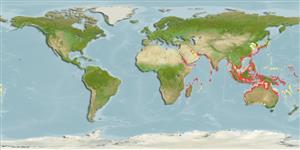Not assigned |
Squamata |
Elapidae
Environment: milieu / climate zone / djupintervall / distribution range
Ekologi
Revassocierade; djupintervall 7 - 40 m (Ref. 356). Tropical; 49°N - 36°S (Ref. 356)
Indo-West Pacific: from the Persian Gulf to Japan and the Indo-Australian Archipelago.
Length at first maturity / Size / Weight / Age
Könsmognad: Lm 70.0 range ? - ? cm Max length : 190 cm TL hane/ej könsbestämd; (Ref. 801)
Data from Malaya indicate that this sea snake has caused more deaths than any sea snake. A fowl bitten was reported to die in eight minutes (Ref. 88062). Minimum depth from Ref. 103587. Inhabits coastal waters. Ovoviviparous. Feeds on fish (Ref. 801).
Life cycle and mating behavior
Könsmognad | Reproduktion | Lek | Eggs | Fecundity | Larvae
It bears 3 to 16 young in a brood (Ref. 88062).
de Silva, A. 1994 An account of the sea snakes (Serpentes : Hydrophiidae) of Sri Lanka. pp. 234-249, In Gopalakrishnakone, P. (ed.). Sea Snake Toxinology. Venom & Toxin Research Group. National University of Singapore. 251 p. (Ref. 88062)
IUCN Red List Status
(Ref. 130435: Version 2025-1)
CITES status (Ref. 108899)
Not Evaluated
Not Evaluated
Threat to humans
Human uses
| FishSource |
Verktyg
Ytterligare information
Population dynamicsTillväxtMax. ages / sizesLength-weight rel.Length-length rel.Length-frequenciesMass conversionAbundans PhysiologySyreförbrukning
Human RelatedStamps, coins, misc.
Internet-källor
Estimates based on models
Preferred temperature
(Ref.
115969): 23.1 - 29.2, mean 28.1 (based on 1654 cells).
Fishing Vulnerability
Very high vulnerability (82 of 100).
Price category
Unknown.
